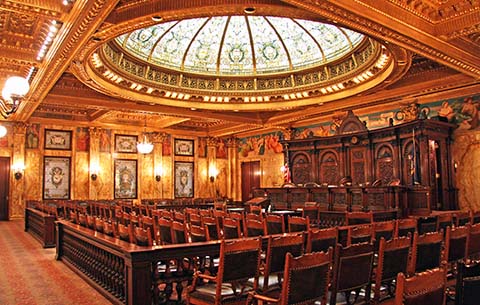
 Department of Citywide Administrative Services311
Department of Citywide Administrative Services311 Search all NYC.gov websites
Search all NYC.gov websites
Manhattan Appellate Courthouse

New York, NY 10013
Date Built: 1900
Architect: James Brown Lord
The Manhattan Appellate Courthouse is home to the Appellate Division, First Department of the New York State Supreme Court. The court hosts over 3,000 appeals and more than 7,000 motions a year, making it one of the busiest appellate courts in the United States. The main work of the Court involves appeals from the Supreme Court, the Surrogate's Court, and the Family Court in New York and Bronx Counties. It is one of the most important courts in New York State and has enormous significance to the legal community. It is an anchor for Madison Square, which is surrounded by early twentieth century classical style buildings.
The Appellate Division was established in 1894 as one of the last of a series of reforms of the judicial system in the later nineteenth century. The right of appeals was extended and this court was to handle the appeals and relieve some of the work load of the State Supreme Court.
The court was located in rented office space on Fifth Avenue and 19th Street in 1896 when plans were made for a new building to respond to the increasing number of appeals for the court to hear. The justices themselves selected the site for the building at Madison Square for their courthouse. They were George C. Barrett, Charles C. Van Brunt. William Rumsey, Edward Patterson, and Morgan J. O'Brien. The site was in a residential neighborhood in Midtown, probably close to the justices' homes. The other courts were situated in Lower Manhattan in the Civic Center. The Congressman who owned the site sold it to the City for $370,000. The architect James Brown Lord was given the then unheard of sum of $700,000 to construct the courthouse. Responding to the "City Beautiful" movement, Lord was instructed to use a large percentage of the construction budget for decoration. Despite spending a third of the total cost on decorative features, like statues and murals, he managed to complete the building under budget by over $60,000.
This spectacular marble-faced Beaux Arts style courthouse is three-stories high. The front facade on 25th Street, is dominated by an imposing triangular pedimented entrance portico supported by six Corinthian columns. The Madison Avenue facade is no less striking, with a two-story flat cornice supported by four fluted Corinthian columns. A five-story addition was built in the 1950's which was designed to harmonize with the historic courthouse. Around the same time the statue of Mohammed was removed at the request of representatives of various Muslim nations, responding to the Islamic canon which forbids the representations of humans in sculpture or painting.
The building is most well known for the unique blending of art and architecture, a major principle of the Beaux Arts movement. On the outside, there are about 30 figures by 16 sculptors, the most sculptors to work on a single building in the United States. The artists were well-known in their field, like Daniel Chester French and Karl Bitter, who were selected by the architect and a panel of their peers. The marble sculptures, which weren't finished until 1901,represent allegorical figures such as Wisdom, Peace, Justice and figures in legal history, such as Moses, Confucius, and Justinian. Exterior sculpture and other exterior and interior decorative work represented over 50% of the total cost of the building.
On the inside, ten famous artists created murals for the main hall and the courtroom. The main hall has an ornate coffered ceiling, a bronze and glass chandelier, Siena marble walls divided by Corinthian pilasters and massive, original, Herter Brothers furniture. The murals depict legal themes. The courtroom has a stained glass dome set into the gilded coffered ceiling. Like the main hall, there are spectacular marble walls, murals, and original furniture.
The exterior of the courthouse was designated a New York City Landmark in 1966, and the interior in 1981. The courthouse is also listed in the New York State and National Registers of Historic Places.


